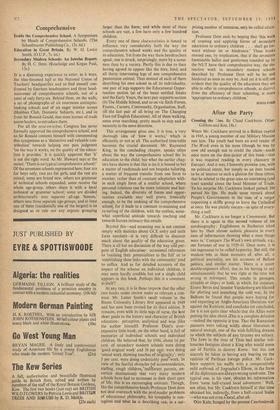Comprehensive
IT is a disarming experience to enter, as it were, the blue-linsoned hall at the National Union of Teachers' headquarters and to find oneself con- fronted by fourteen headmasters and three head- mistresses of comprehensive schools, out of a total of only forty-six. Behind them, on the walls, a set of photographs of six enormous antiseptic- looking schools and of six eager interior scenes (Hobbies Club, Domestic Subjects, etc.), and in front Sir Ronald Gould, that most human of trade unionieaders, to introduce them.
For all the raise-en-scene, Congress has never formally approved the comprehensive school, and so Sir Ronald contents himself with commending this symposium as a 'distinctive and valuable con- tribution' towards helping one pass judgment 'on the way it works, on the quality of the educa- tion it provides.' It is quickly apparent that 'it' is not the right word. As Mr. Howard says at the outset, 'There is no typical comprehensive school!' Of the seventeen schools represented here, four are for boys only, two are for girls, and the rest are mixed; some are brand new, others are grammar or technical schools expanded; some receive the whole age-group, others shire it with a local technical or grammar school; some are divided architecturally into separate all-age 'houses,' others into three separate age-groups, and at least one of them (incidentally one of the largest) is so designed as to rule out any organic grouping
larger than the form; and while most of these schools are vast, a few have only a few hundred children.
Every one of these characteristics is bound to influence very considerably both the way the comprehensive school works and the quality of its education. Yet from the way these headteachers speak, one is struck, surprisingly, more by a same- ness than by a variety. Partly this is due to their having agreed to appear like the fore, hind, and all thirty intervening legs of one comprehensive pantOmime animal. Thus instead of each of them describing his own school in all its individuality, one pair of legs supports the Educational Oppor- tunities section (a) of the beast entitled Intake and the Early Years, the next pair supports section (b) The Middle School, and so on via Sixth Forms, Exams., Careers, Community, Organisation, Staff, till the last pair of all bring on The Changing Face (of English Education). All of them walking, some even marching, pretty much in step and of necessity in the same direction.
This arrangement gives one, it is true, a very thorough idea of 'how it works,' which is efficiently or not at all. The authorised time-table becomes the crucial document.. Mr. Raymond King, in the concluding chapter, speaks often about the way the comprehensive school fits its education to the child; but what the earlier chap- ters have shown is that this is (as it is bound to be) a matter of readymade and not bespoke tailoring, a matter of frequent transfer from one form to another, rather than of constant adaptation with- in each single form of a smaller school, where personal relations can be more intimate and last- ing. Indeed, the diversity of forms and oppor- tunities available may well prove, ironically enough, to be the undoing of the comprehensive school, for it leads to a constant re-assessing and re-sorting of the children, with the restless, some- what superficial attitude towards teaching and towards human intimacy this entails.
Beyond this—and assuming one is not content, simply. with statistics about GCE entry and sixth form numbers—it is very difficult to discover much about the quality of the education given. There is all but no discussion of the way and pur- pose of English education : occasional references to 'realising their •potentialities to the full' or to 'establishing close links with the community',tend to suffice. And as for detailed accounts of the impact of the scheme on individual children, it may seem hardly credible but not a single child appears in this book. Perhaps this is a comment in itself?
At any rate, it is in these respects that the other two books under review make so relevant a con- trast. Mr. Lester Smith's small volume 'in the Home University Library first appeared in 1949 and has now been revised for its third edition. It remains, even with its little tags of verse, the Lest short guide to the history and character of British education : perceptive, analytical and wise (like the author himself). Professor Dent's Over- expensive little book, on the other hand, is full of memories of individual schools and individual children. He believed that, by '1956, about 16 per cent. of secondary modern schools were doing 'good original work' and 36 per cent. were doing 'sound work showing touches of originality'; only 5 per cent. were doing undeniably poor work. In view of the fearful obstacles of accommodation, staffing,' rough children,iindifferent parents, un- certain destinations) that very many modern schools have had to surmount in their short span of life, this is an encouraging estimate. Though, like the comprehensive heads,sProfessor Dent does not deal overmuch with the profounder problems of educational philosophy, his sympathy is con- tagious and what he is describing can, in a sur-
prising number of instances, only be called educa- tion.
Professor Dent ends by hoping that 'this work of creating and applying forms of secondary education to ordinary children . . . shall go for- ward without let or hindrance.' These books remind one, by implication, that if the seventeen formidable ladies and gentlemen rounded up by the NUT have their comprehensive way, the dis- tinctive work in secondary modern schools described by Professor Dent will be let and hindered as soon as may be. And yet it is still not evident that the quality of the education they are able to offer in comprehensive schools, as distinct from the efficiency of their schooling, is more `appropriate to ordinary children.'
BORIS FORD


































 Previous page
Previous page